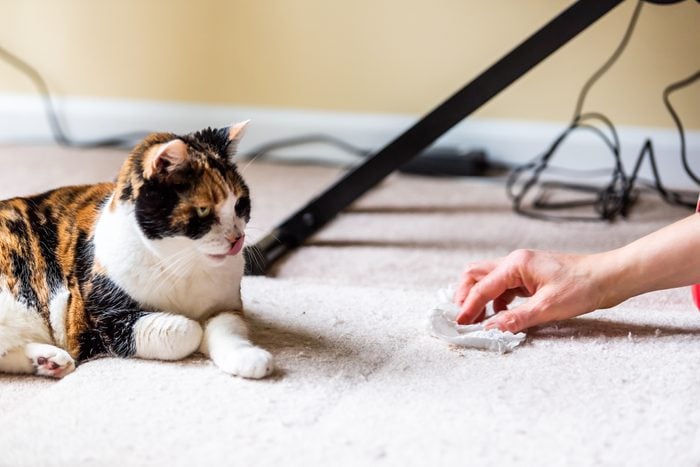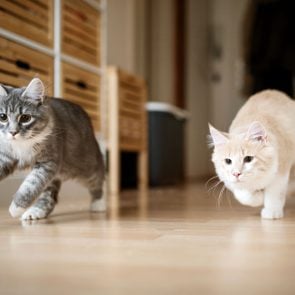How to Stop Your Cat from Peeing on the Carpet
Updated: Apr. 24, 2024

It’s one of those mysteries of cat behavior that every cat parent faces at some point: One day, your well-mannered cat is fine, and the next, he’s turned the living room rug into his litter box and you’re desperately trying to figure out how to stop your cat from peeing on the carpet. Call it pee-mail because your cat is sending you a message. “Cats don’t display behaviors just to display them,” says certified cat behaviorist Pam Johnson-Bennett. “They’re always serving a purpose. So if your cat suddenly pees on carpet, you should view it as a red flag. Something has happened, and it needs your attention.”
So what makes a cat suddenly abandon its litter box? The answers can be complicated. “There is one main thing to figure out before we can treat it, and that’s determining if it’s a medical issue or a behavioral issue,” says Ashlie Saffire, DVM, of the Faithful Friends Veterinary Clinic in Dublin, Ohio. “We tell our pet parents that when house-soiling starts, they need to come in right away. The longer you wait to correct the problem, the harder it can be to reverse. And, of course, if it’s a medical issue, you don’t want it going untreated too long.”
Once you can pinpoint the reason, it becomes a whole lot easier to address the issue. And while stepping into a puddle of cat pee can try the patience of even the most devoted cat parent, it might help to think of it as your cat’s way of asking for help. “It’s not your cat being spiteful, and it’s not something to be punished,” says Johnson-Bennett. “Their behavior is typically a result of them trying to solve a problem.”
Here are some of the most common reasons why cats pee outside their litter boxes—and our experts’ best advice on how to stop it from happening. When you’ve gotten this problem under control, you’ll also want to learn how to train cats in other ways, from keeping them from scratching the furniture to keeping them off the counters.
Get Reader’s Digest’s Read Up newsletter for more pets, humor, cleaning, travel, tech and fun facts all week long.
Why is my cat peeing on the carpet?
Before you can implement a plan for how to stop your cat from peeing on the carpet, you need to understand the motivation behind what’s going on. There are any number of reasons why a cat might suddenly decide to pee on carpet, says Johnson-Bennett, but they tend to fall into three general areas. Some incidents are an indication of a health issue; others are a sign that the cat is unhappy with its litter box; and the remainder tend to be connected to stressors in the cat’s home environment.
Your cat may have a urinary tract issue
Any time a cat pees outside its litter box, it’s important to get the cat checked out by a vet ASAP—even if you think the reason is behavioral. “It could be crystals or urine stones, which develop in the bladder and can be really painful,” says Dr. Saffire. “There’s also a disease called cystitis, which is inflammation of the bladder wall, and that’s probably the most common medical cause that I see for urinating outside the litter box. It’s called painful bladder syndrome because the cat is in so much pain, it’s just going to urinate wherever it wants.” Stress can be a major contributor to feline lower urinary tract disease, though it’s not the only cause.
You have the wrong litter box
“People set up litter boxes based on what’s convenient for them, more than what is better for the cat,” says Johnson-Bennett. “Very often, we choose litter boxes that are too small, and anyone who has ever had to use an airplane lavatory knows how uncomfortable that can be.” Covered litter boxes can make that space feel even more cramped. Johnson-Bennett suggests an uncovered box that is about twice as big as the cat itself. “Make sure your cat can get in there, turn around, eliminate and cover a couple of times,” she says.
The litter box is dirty
It goes without saying that cats like their litter boxes clean. Dirty litter boxes are one of the most common reasons why a cat will pee on carpet. If you can’t scoop at least once a day, consider a self-cleaning litter box to keep your cat on the straight and narrow.
Is your cat peeing all the time? That’s another reason your cat should see the vet: Cats with diabetes and kidney disease have to urinate frequently, which can leave their litter boxes flooded with urine. “They don’t want to go in it because it’s dirty all the time,” says Dr. Saffire.
Your cat is having trouble getting to the box
We tend to keep our litter boxes out of sight, often in the far reaches of the basement. But as cats get older, it may become harder to make that long walk downstairs. “You want to make it as easy as possible for them to use the litter box,” says Dr. Saffire. “That can especially [be an issue] when you have an older cat who has arthritis or issues with vision, and now they have to go into a scary, dark basement downstairs. It hurts to get down the stairs, and they’re like ‘Unh-unh! I’m going to go right here on the carpet because it’s way more comfortable and easy for me.'”
Dr. Saffire also points to studies that suggest chronic pain can be a trigger for house soiling. “We now know that cats that are declawed are seven times more likely to house-soil,” she says. “It’s because they’re more prone to arthritis in their back and their feet, and they’re just uncomfortable.”
Your cat is feeling stressed
Cats that live in busy households with kids and other pets may be too stressed to pass through the chaos on their way to the litter box. “It may be that one cat maybe gets ambushed by another cat every time he tries to use the box, so he stops trying,” says Johnson-Bennett. “Or maybe the family dog goes after him.”
Johnson-Bennett suggests setting up a video camera in the room where the cat has been soiling. “When it happens, you can go back and see what happened 30 seconds before the cat eliminated outside the box. You might notice that maybe there was a fight between two cats, or maybe the cat saw another cat outside the window.”
There’s been a change at home
Cats hate change. So sometimes the problem that shows up as a litter-box problem is not related to the litter box at all but to something that has changed in the household. “Cats like predictability and routine,” says Johnson-Bennett. “It can be something as simple as you changed brands of food abruptly, or you’ve changed your work schedule and the cat that was used to being fed at 5 o’clock is now getting fed at 8. Or it could be there’s been a divorce or the kids have gone off to college. You have to look at the dynamics and see what’s going on there.”
How do I get my cat to stop peeing on the carpet?
Once you know the reason for your cat’s behavior, it becomes easier to rectify the problem and figure out how to stop your cat from peeing on carpet. “Based on what the problem is, you have to develop a treatment plan that’s workable,” says Johnson-Bennett.
Get a clean bill of health at the vet
If your cat’s litter-box avoidance is due to an issue with their urinary tract or other health condition, getting medical treatment at the vet should solve the problem. “Very often, cats associate the pain they feel with the litter box, so they think if they go somewhere else, it won’t hurt as much,” says Johnson-Bennett. Once they’re feeling well again, they should return to the litter box.
Up your litter-box game
The general rule is that there should be one more litter box than there are cats in the house. “Sometimes just adding a second litter box can make a world of difference for a cat, and they’ll start using their box again,” says Dr. Saffire. Cats tend to prefer large, uncovered boxes filled with 3 to 4 inches of unscented clumping litter.
And they like having the boxes strategically place in different areas of the home. “We try to make our cats all go to the bathroom in the basement, and sometimes that’s not where they want to go,” Dr. Saffire says. “So usually a litter box in every level of the house is really important. You want to make it as easy as possible for them to use the litter box. If you want to deter them from urinating on the carpet, you have to give them options.”
Respect their scent
Cats sometimes use urine spraying as a way to mark their territory and make themselves feel safe. Pheromone diffusers like Feliway can help calm cats by mimicking natural feline pheromones. “A lot of times, we’ll recommend that you put this plug-in in the room where the cat is urinating outside of the box,” says Dr. Saffire. “It essentially marks the room for them. So when the cat comes in there ready to mark, he smells it and says, ‘Oh, wait—I’ve already marked this room. It’s good.'”
Give them what they need
“A lot of times, behavior can be changed by what we call environmental enrichment,” says Dr. Saffire. “Things that you can do to enrich the cat’s life at home can reduce their behavior of urinating outside the litter box.” Among them: Make sure the cat has a safe place where they can hide when they’re scared or stressed, and provide them with multiple food and water sources. “We see a lot more house-soiling with multi-cat homes because people make the cats all eat together,” says Dr. Saffire. “If you don’t give them an option to eat separately, that can sometimes be a really big stressor for cats. So what they’ll do is they’ll mark their territory by urinating outside their box.” By the way, if you’re having literal cat fights in your home, here’s how to stop a cat from bullying another cat.
Dr. Saffire also recommends food puzzles to give cats a way to indulge their natural hunting instincts as a way to relieve stress. Bonus: These interactive cat toys will also keep them entertained and mentally stimulated.
Keep change to a minimum
Obviously, you can’t always control the big changes in your life, but do try to keep in mind that they affect your cat’s life too. Set up a routine for your cat that includes regular meal times, as well as brushing and play sessions. “If you can’t make your schedule more predictable, then consider using timed feeders or ask the neighbor to come over and feed your cat when you can’t,” says Johnson-Bennett.
Avoid negative reinforcement
“The one thing I tell people is, ‘Definitely do not ever do negative punishment,'” says Dr. Saffire. “Cats only respond to positive. A lot of people like to use squirt guns and squirt the cat if they’re doing something they don’t want it to do. But unfortunately, that’s just going to make them scared of their owner, and you’re not there 24 hours a day to watch them.”
Instead, she says, praise the cat when it engages in the correct behavior, especially if you catch them in the act. “If they use the litter box, all the praise!” she says. “They’re like little toddlers. No yelling—just treats and praise.”
Tips for getting cat pee out of carpet
While you get your cat on the road to recovery, you’ll also need to deal with the soiled carpet. Cat urine contains uric acid, which makes its lingering odor particularly unpleasant. And getting the smell of cat pee out of a carpet isn’t easy. To make sure you’re tackling it the right way, check out the following advice from the experts on how to get cat pee out of carpet.
- Get to it fast. The more cat urine sinks into carpet, the harder it is to get out. “If it’s a one-time thing and you get on it quickly, you should be able to get every trace of the urine out,” says Johnson-Bennett. “But if a carpet has been repeatedly urinated on, so much so that it has soaked through the carpet and the padding underneath, then you may have to replace the carpet or cut out that part.”
- Use an enzymatic cleaner. “It’s really important that you use a cleaner that has an enzymatic component to neutralize the ammonia in the urine,” says Dr. Saffire. “Otherwise, the cat is just going to keep coming back to that same spot and marking it. Nature’s Miracle is probably one of the most commonly known enzymatic cleaners, but there’s another called Anti-Icky-Poo that works really well too.” In a pinch, you can also try plain white vinegar. “The best thing is to use a product specifically designed for cat urine,” says Johnson-Bennett, “but vinegar can also help neutralize the odor.”
- Go deep. “You want to make sure to get every bit,” says Johnson-Bennett. “Cats have 200 million scent receptors in their nasal cavity. We have 5 million. So if you don’t get it up really well, they’ll still smell it, and that can trigger them to go back there again. Whatever product you use, make sure you let it saturate all the way down and make sure you’re getting the whole area.”
- Find hidden spots with a black light or UV flashlight. If you turn off the lights in a room and shine a black or UV light around, any spots with urine (or other bodily substances like cat barf) will fluoresce, which can help you know where to clean. “Sometimes we think we know where they’re going, and we don’t realize we’re missing a lot of the spots,” says Dr. Saffire. Another trick to zero in on these stains and smells: Take painters tape and outline every area that fluoresces under the black light. “That way, when I turn the lights back on and I go to clean everything, I know the spots I have to hit,” says Johnson-Bennett.
- Don’t rely on cat deterrents. Yes, scents like citrus can be a turnoff for cats, but deterrents alone won’t solve the problem. “Any deterrents that you use will just drive the cat to go somewhere else,” says Johnson-Bennett. “I’ve also had clients whose cats have peed right on the deterrent. The problem becomes bigger than their dislike for the deterrent.”
- Cover the area to prevent repeat soilings. Take an office mat and flip it upside down so that the side with those tiny bumps is facing up. “Cats don’t want to walk over that,” says Dr. Saffire. “And put a litter box nearby. If you’re going to deter the cat from using that spot, then you have to give them an option, at least until you figure out what the real problem is.”
Ultimately, figuring out how to stop a cat from peeing on the carpet will likely involve both detective work and patience. Rule out anything medical. Make sure the litter box and its location are to the cat’s liking. And then try and determine if there is something in the household’s dynamics that is upsetting the cat. “The best deterrent is to figure out what the cause is and then eliminate it or modify it so that your cat feels more comfortable,” says Johnson-Bennett. “You need to give the cat the help it needs to solve the problem.”
Sources:
- Pam Johnson-Bennett, certified cat behaviorist, author of Think Like a Cat and owner of the private veterinarian-referred behavior company Cat Behavior Associates in Nashville, Tn.
- Ashlie Saffire, DVM, DABVP (Feline), at Faithful Friends Vet Clinic in Dublin, Ohio, and a member of the board of directors for the American Association of Feline Practitioners



